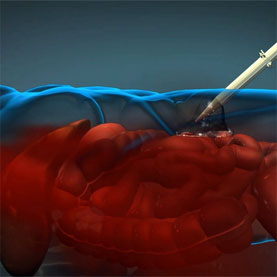It looks like you're using an Ad Blocker.
Please white-list or disable AboveTopSecret.com in your ad-blocking tool.
Thank you.
Some features of ATS will be disabled while you continue to use an ad-blocker.
4
share:
While this technology is being developed for the battlefield, it could be very beneficial for trauma patients being treated by EMTs at an accident
scene to stabilize a seriously injured victim. It could greatly extend the time an ambulance or life flight copter has to get the injured person to
the hospital.
SOURCE
Field medics want to use a novel foam to seal off hemorrhaging organs, but safety concerns persist
SOURCE
Despite their best efforts to stabilize abdominal wounds sustained on the battlefield, military first-responders have few options when it comes to stanching internal bleeding caused by, for example, gunshots or explosive fragments. The Defense Advanced Research Projects Agency (DARPA) says it is studying a new type of injectable foam that molds to organs and slows hemorrhaging. This could provide field medics with a way to buy more time for soldiers en route to medical treatment facilities.
“We’ve been waiting for this," says Donald Jenkins, trauma director at Saint Mary’s Hospital in Rochester, Minn., and a 24-year Air Force veteran who has spent more than 700 days in combat zones, including in Afghanistan and Iraq. When asked how often he has seen soldiers suffer from abdominal hemorrhaging caused by explosives or gunshot wounds, he pauses and says, “Too many times.”
The polyurethane foam begins as two liquids stored separately and injected together into the abdominal cavity. One liquid is a polyol, a type of alcohol. The other is made of isocyanates, a family of highly reactive chemicals widely used in the manufacture of flexible and rigid foams. Within about one minute after a medic inserts the liquids at the midline—near the belly button—the mixture expands to nearly 30 times its original volume and then turns solid. It slows or halts hemorrhaging by sealing wounded tissues. Once the patient can get to intensive care, doctors would remove the solid mass and then perform surgery to permanently stop any bleeding.
Jenkins points out another potential problem: Pieces of solidified foam could break off inside the body and go adrift in a patient’s bloodstream, eventually blocking blood flow to the legs or lungs. Sharma says the researchers have not seen any evidence of this happening, however.
reply to post by happykat39
A case of science catching up with fiction! Over the past several years I have seen a few movies where such a foam was injected into wounds to
stop bleeding (Blade Trinity comes to mind). Now if they will just make a food replicator like on Star Trek I can die happy- with an immediately
satisfied tummy!
new topics
-
Maestro Benedetto
Literature: 52 minutes ago -
Is AI Better Than the Hollywood Elite?
Movies: 1 hours ago -
Las Vegas UFO Spotting Teen Traumatized by Demon Creature in Backyard
Aliens and UFOs: 4 hours ago -
2024 Pigeon Forge Rod Run - On the Strip (Video made for you)
Automotive Discussion: 5 hours ago -
Gaza Terrorists Attack US Humanitarian Pier During Construction
Middle East Issues: 5 hours ago -
The functionality of boldening and italics is clunky and no post char limit warning?
ATS Freshman's Forum: 6 hours ago -
Meadows, Giuliani Among 11 Indicted in Arizona in Latest 2020 Election Subversion Case
Mainstream News: 7 hours ago -
Massachusetts Drag Queen Leads Young Kids in Free Palestine Chant
Social Issues and Civil Unrest: 7 hours ago -
Weinstein's conviction overturned
Mainstream News: 9 hours ago -
Supreme Court Oral Arguments 4.25.2024 - Are PRESIDENTS IMMUNE From Later Being Prosecuted.
Above Politics: 10 hours ago
4

